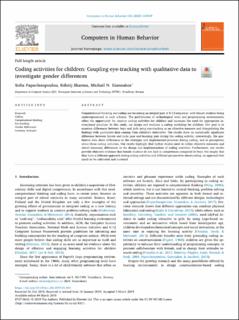| dc.contributor.author | Papavlasopoulou, Sofia | |
| dc.contributor.author | Sharma, Kshitij | |
| dc.contributor.author | Giannakos, Michail | |
| dc.date.accessioned | 2020-04-17T09:16:03Z | |
| dc.date.available | 2020-04-17T09:16:03Z | |
| dc.date.created | 2019-09-25T12:03:42Z | |
| dc.date.issued | 2019 | |
| dc.identifier.issn | 0747-5632 | |
| dc.identifier.uri | https://hdl.handle.net/11250/2651470 | |
| dc.description.abstract | Computational thinking and coding are becoming an integral part of K-12 education, with female students being underrepresented in such subjects. The proliferation of technological tools and programming environments offers the opportunity for creative coding activities for children and increases the need for appropriate instructional practices. In this study, we design and evaluate a coding workshop for children. Our goal is to examine differences between boys and girls using eye-tracking as an objective measure and triangulating the findings with qualitative data coming from children's interviews. The results show no statistically significant difference between female and male gaze and learning gain during the coding activity; interestingly, the qualitative data show differences in the strategies and implemented practices during coding, and in perceptions about those coding activities. Our results highlight that further studies need to utilize objective measures and unveil necessary differences in the design and implementation of coding activities. Furthermore, our results provide objective evidence that female students do not lack in competences compared to boys, but simply that they have a different approach during coding activities and different perspectives about coding, an approach that needs to be cultivated and nurtured. | en_US |
| dc.language.iso | eng | en_US |
| dc.publisher | Elsevier | en_US |
| dc.rights | Attribution-NonCommercial-NoDerivatives 4.0 Internasjonal | * |
| dc.rights.uri | http://creativecommons.org/licenses/by-nc-nd/4.0/deed.no | * |
| dc.title | Coding activities for children: Coupling eye-tracking with qualitative data to investigate gender differences | en_US |
| dc.type | Peer reviewed | en_US |
| dc.type | Journal article | en_US |
| dc.description.version | publishedVersion | en_US |
| dc.source.journal | Computers in Human Behavior | en_US |
| dc.identifier.doi | 10.1016/j.chb.2019.03.003 | |
| dc.identifier.cristin | 1728806 | |
| dc.relation.project | EC/H2020/787476 | en_US |
| dc.relation.project | Norges forskningsråd: 290994 | en_US |
| dc.relation.project | Norges forskningsråd: 255129 | en_US |
| dc.description.localcode | © 2019 The Authors. Published by Elsevier Ltd. This is an open access article under the CC BY-NC-ND license (http://creativecommons.org/licenses/by-nc-nd/4.0/).T | en_US |
| cristin.unitcode | 194,63,10,0 | |
| cristin.unitname | Institutt for datateknologi og informatikk | |
| cristin.ispublished | true | |
| cristin.fulltext | postprint | |
| cristin.qualitycode | 1 | |

